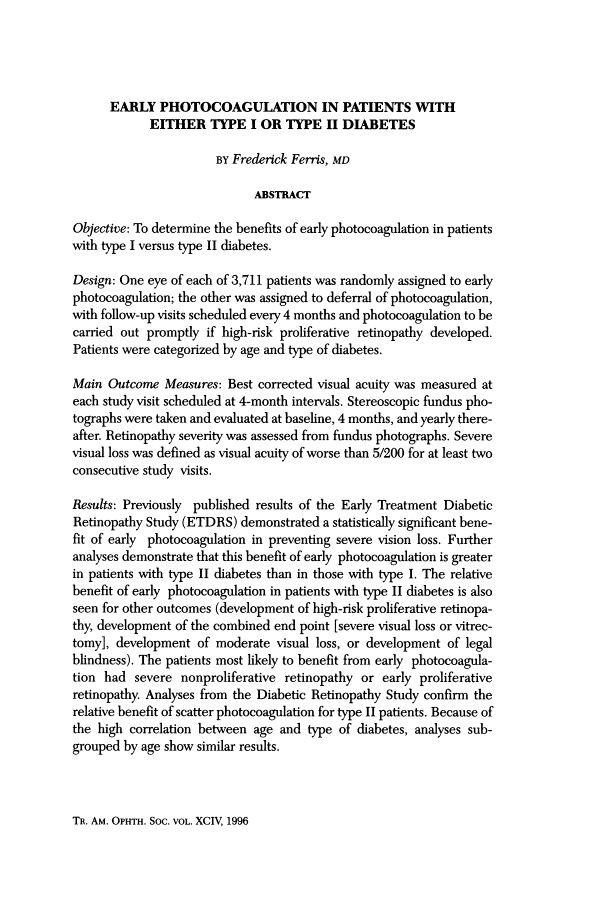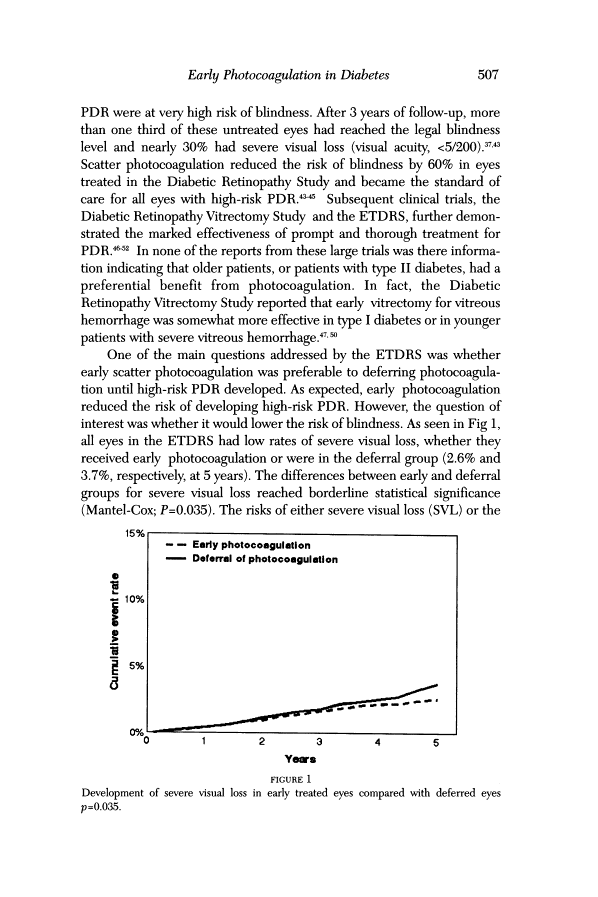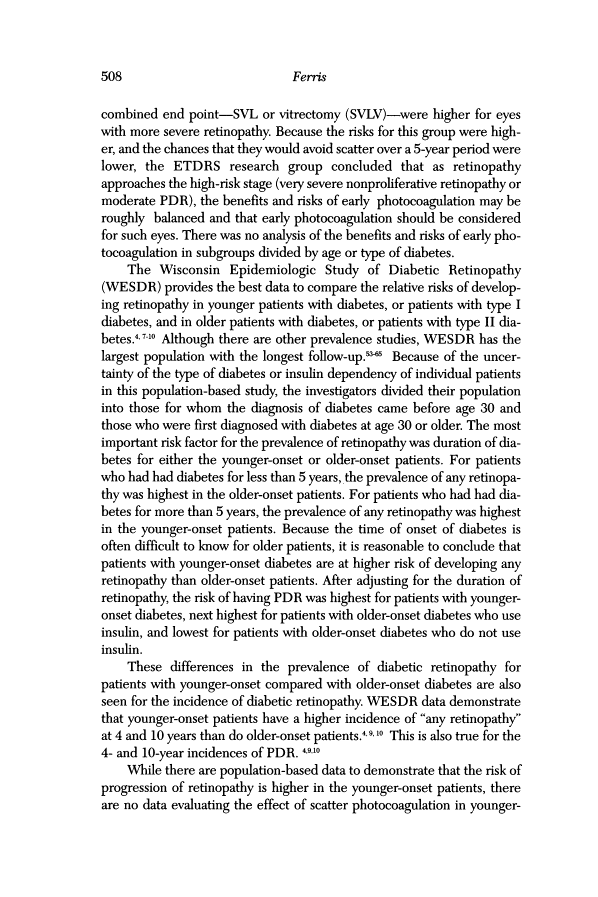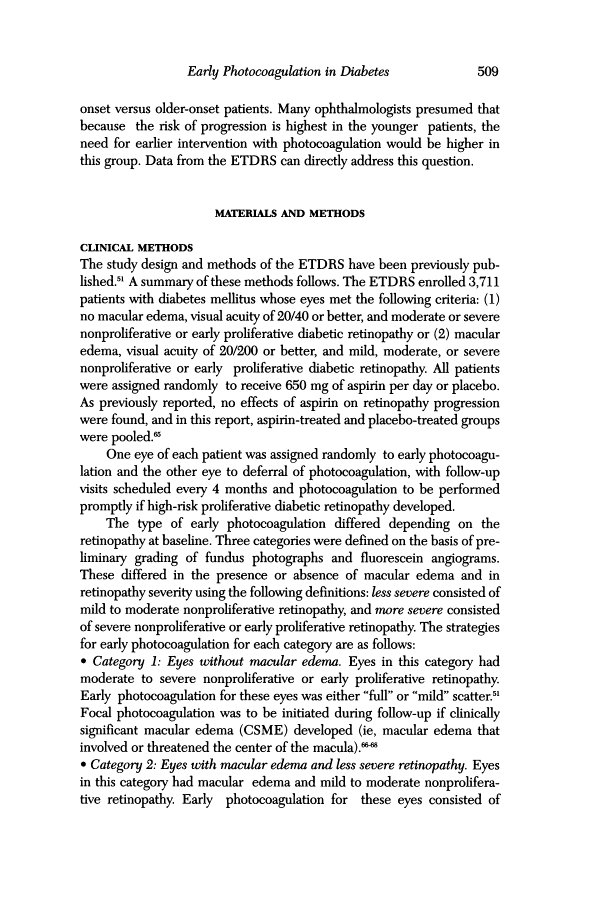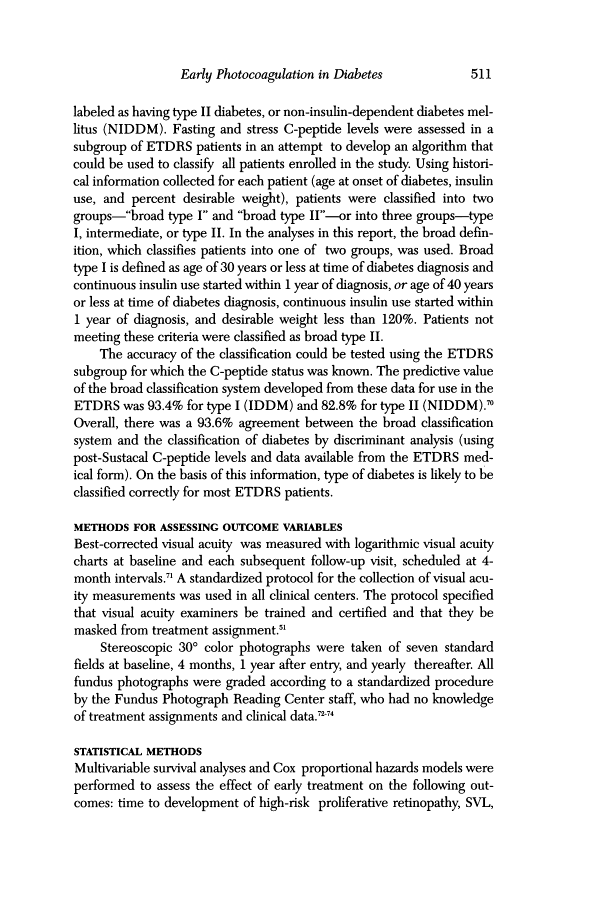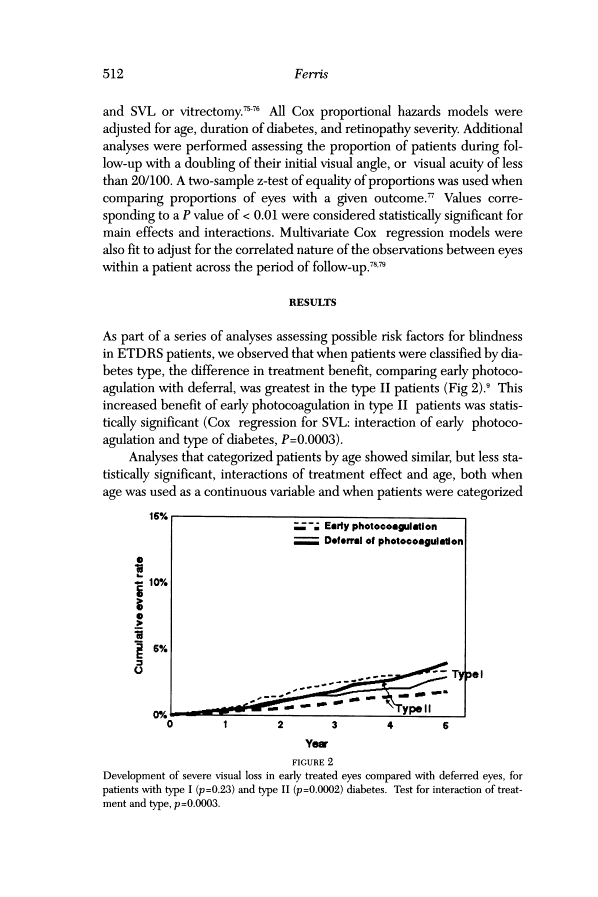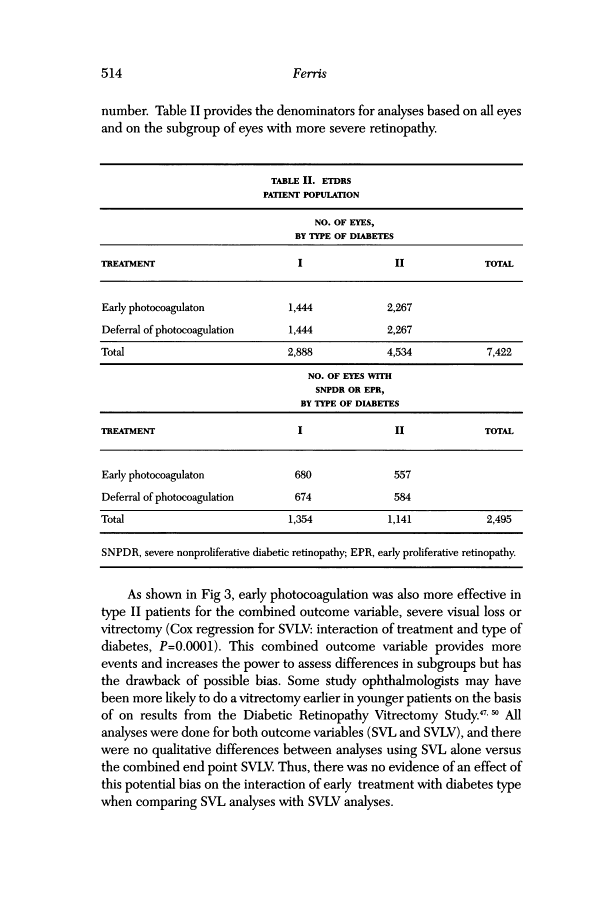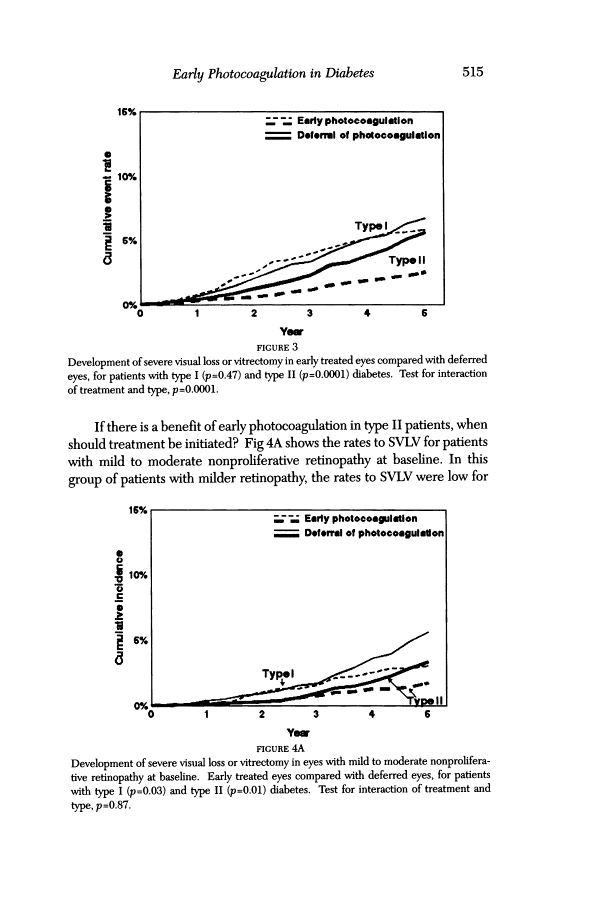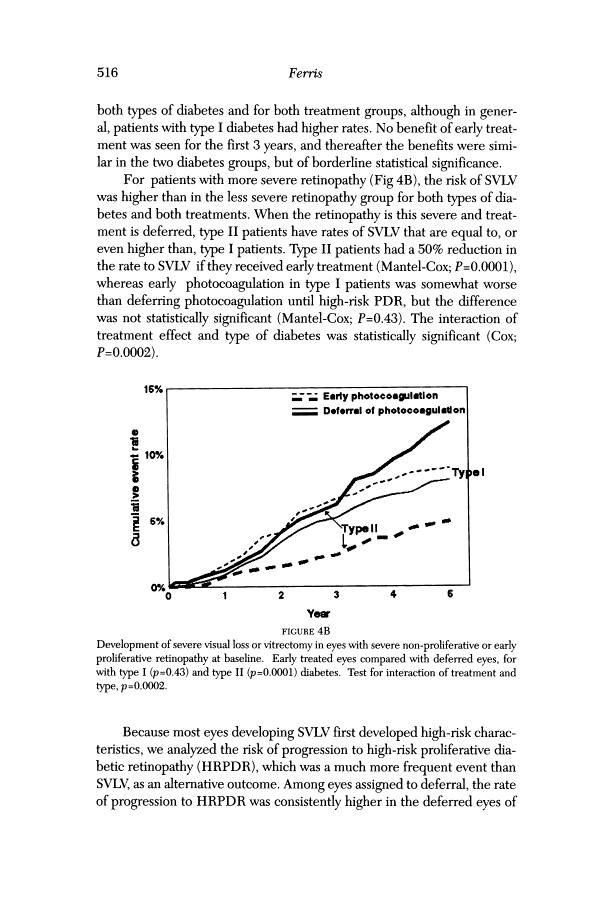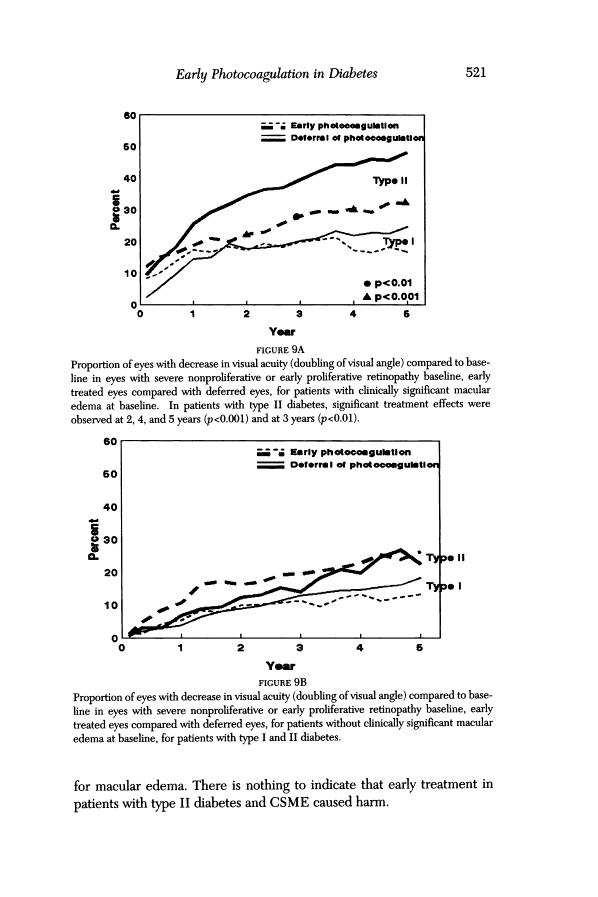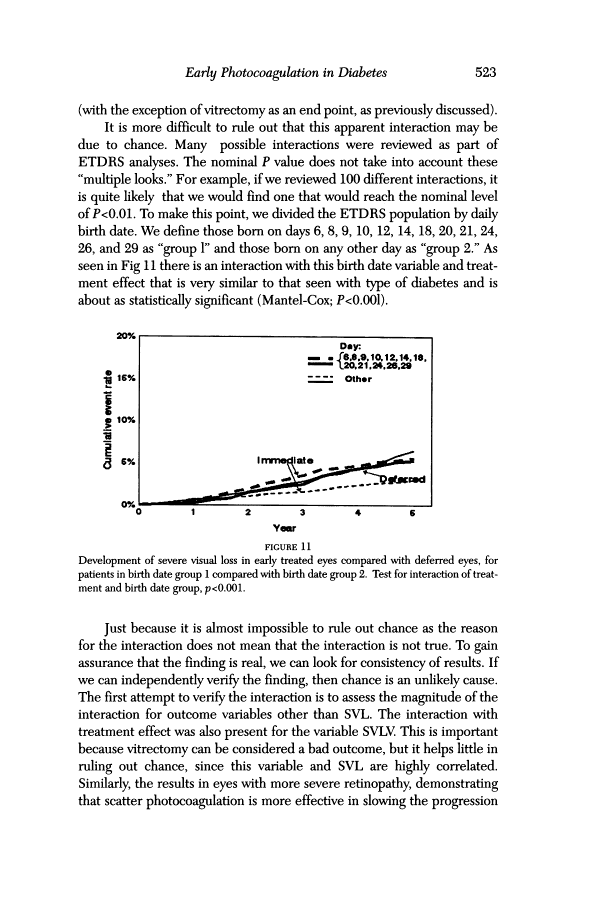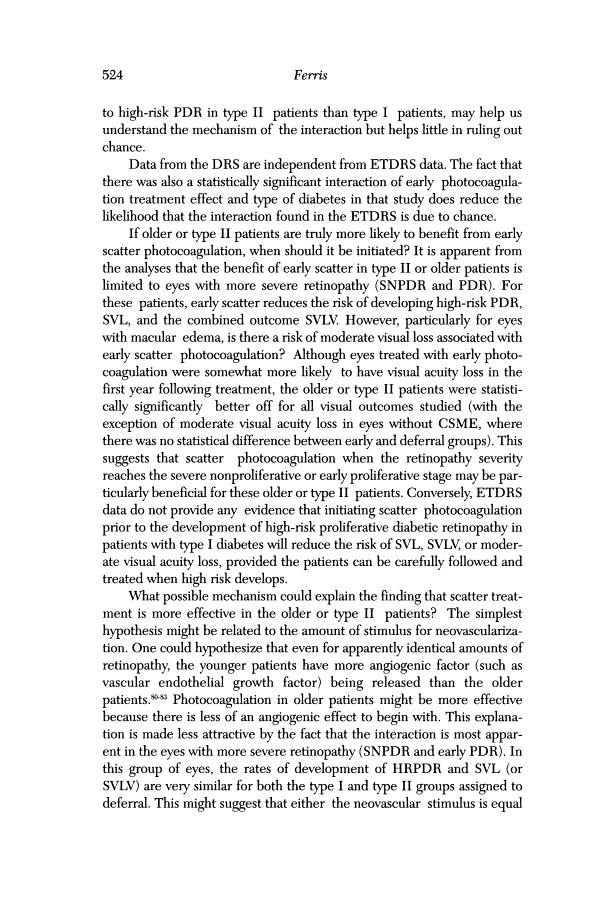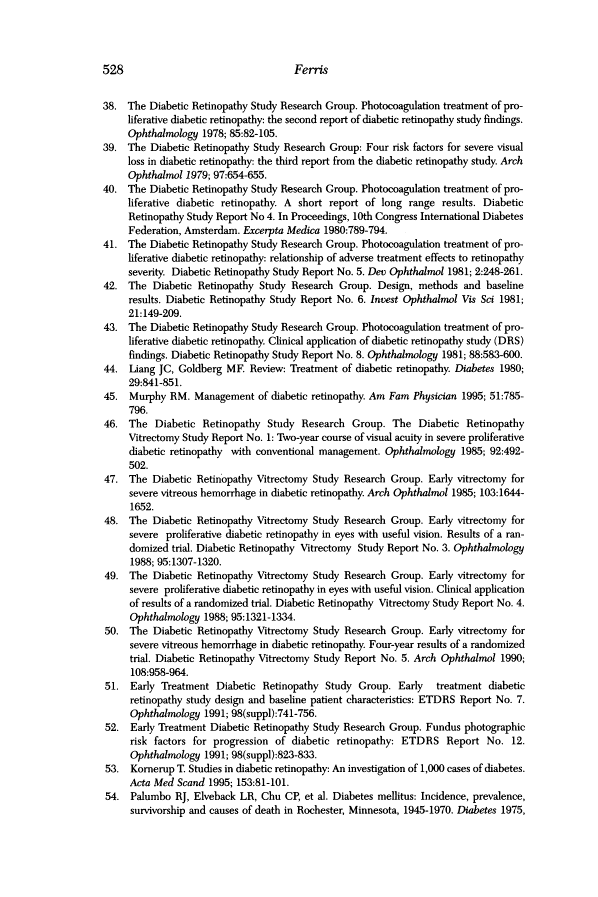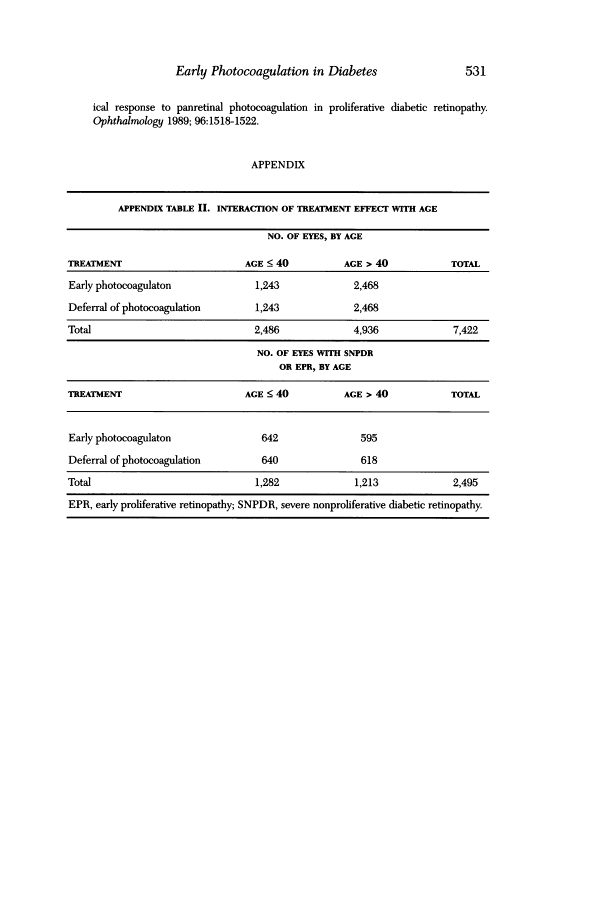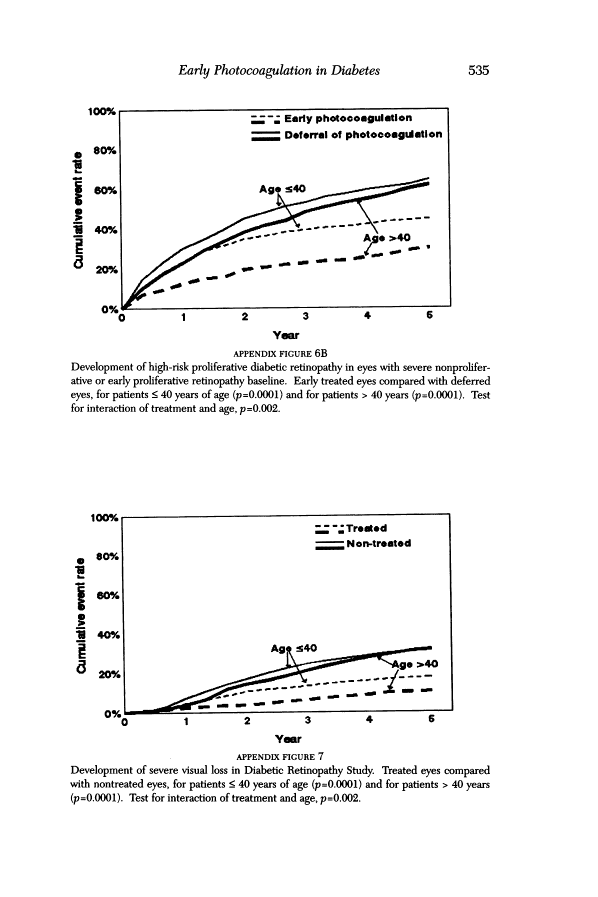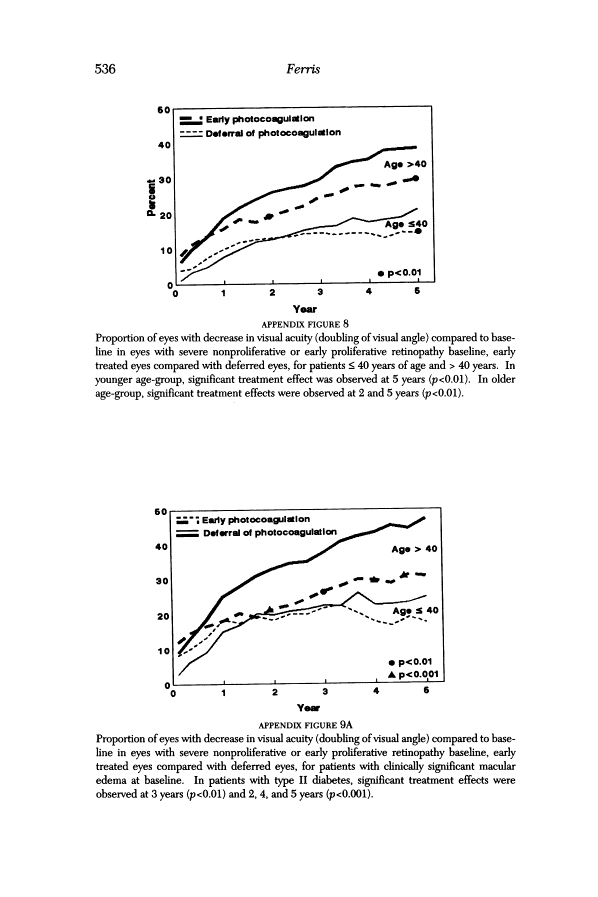Abstract
Objective
To determine the benefits of early photocoagulation in patients with type I versus type II diabetes.Design
One eye of each of 3,711 patients was randomly assigned to early photocoagulation; the other was assigned to deferral of photocoagulation, with follow-up visits scheduled every 4 months and photocoagulation to be carried out promptly if high-risk proliferative retinopathy developed. Patients were categorized by age and type of diabetes.Main outcome measures
Best corrected visual acuity was measured at each study visit scheduled at 4-month intervals. Stereoscopic fundus photographs were taken and evaluated at baseline, 4 months, and yearly thereafter. Retinopathy severity was assessed from fundus photographs. Severe visual loss was defined as visual acuity of worse than 5/200 for at least two consecutive study visits.Results
Previously published results of the Early Treatment Diabetic Retinopathy Study (ETDRS) demonstrated a statistically significant benefit of early photocoagulation in preventing severe vision loss. Further analyses demonstrate that this benefit of early photocoagulation is greater in patients with type II diabetes than in those with type I. The relative benefit of early photocoagulation in patients with type II diabetes is also seen for other outcomes (development of high-risk proliferative retinopathy, development of the combined end point [severe visual loss or vitrectomy], development of moderate visual loss, or development of legal blindness). The patients most likely to benefit from early photocoagulation had severe nonproliferative retinopathy or early proliferative retinopathy. Analyses from the Diabetic Retinopathy Study confirm the relative benefit of scatter photocoagulation for type II patients. Because of the high correlation between age and type of diabetes, analyses sub-grouped by age show similar results.Conclusion
These analyses suggest that patients with type II diabetes, or older patients with diabetes, are more likely to benefit from early scatter photocoagulation than patients with type I diabetes. The current standard of care is to initiate scatter photocoagulation as the severity of retinopathy approaches or reaches the high-risk stage, Provided careful follow-up is possible, ETDRS data do not show that initiating scatter photocoagulation prior to the development of high-risk proliferative diabetic retinopathy in patients with type I diabetes will reduce the risk of severe visual loss. ETDRS analyses do indicate that for patients with type II diabetes, it is especially important to consider scatter photocoagulation at the time of the development of severe nonproliferative or early proliferative retinopathy.Free full text

Early photocoagulation in patients with either type I or type II diabetes.
Abstract
OBJECTIVE: To determine the benefits of early photocoagulation in patients with type I versus type II diabetes. DESIGN: One eye of each of 3,711 patients was randomly assigned to early photocoagulation; the other was assigned to deferral of photocoagulation, with follow-up visits scheduled every 4 months and photocoagulation to be carried out promptly if high-risk proliferative retinopathy developed. Patients were categorized by age and type of diabetes. MAIN OUTCOME MEASURES: Best corrected visual acuity was measured at each study visit scheduled at 4-month intervals. Stereoscopic fundus photographs were taken and evaluated at baseline, 4 months, and yearly thereafter. Retinopathy severity was assessed from fundus photographs. Severe visual loss was defined as visual acuity of worse than 5/200 for at least two consecutive study visits. RESULTS: Previously published results of the Early Treatment Diabetic Retinopathy Study (ETDRS) demonstrated a statistically significant benefit of early photocoagulation in preventing severe vision loss. Further analyses demonstrate that this benefit of early photocoagulation is greater in patients with type II diabetes than in those with type I. The relative benefit of early photocoagulation in patients with type II diabetes is also seen for other outcomes (development of high-risk proliferative retinopathy, development of the combined end point [severe visual loss or vitrectomy], development of moderate visual loss, or development of legal blindness). The patients most likely to benefit from early photocoagulation had severe nonproliferative retinopathy or early proliferative retinopathy. Analyses from the Diabetic Retinopathy Study confirm the relative benefit of scatter photocoagulation for type II patients. Because of the high correlation between age and type of diabetes, analyses sub-grouped by age show similar results. CONCLUSION: These analyses suggest that patients with type II diabetes, or older patients with diabetes, are more likely to benefit from early scatter photocoagulation than patients with type I diabetes. The current standard of care is to initiate scatter photocoagulation as the severity of retinopathy approaches or reaches the high-risk stage, Provided careful follow-up is possible, ETDRS data do not show that initiating scatter photocoagulation prior to the development of high-risk proliferative diabetic retinopathy in patients with type I diabetes will reduce the risk of severe visual loss. ETDRS analyses do indicate that for patients with type II diabetes, it is especially important to consider scatter photocoagulation at the time of the development of severe nonproliferative or early proliferative retinopathy.
Full text
Full text is available as a scanned copy of the original print version. Get a printable copy (PDF file) of the complete article (2.4M), or click on a page image below to browse page by page. Links to PubMed are also available for Selected References.
Selected References
These references are in PubMed. This may not be the complete list of references from this article.
- Kahn HA, Hiller R. Blindness caused by diabetic retinopathy. Am J Ophthalmol. 1974 Jul;78(1):58–67. [Abstract] [Google Scholar]
- Kahn HA, Bradley RF. Prevalence of diabetic retinopathy. Age, sex, and duration of diabetes. Br J Ophthalmol. 1975 Jul;59(7):345–349. [Europe PMC free article] [Abstract] [Google Scholar]
- Klein R, Klein BE, Moss SE, Cruickshanks KJ. The Wisconsin Epidemiologic Study of diabetic retinopathy. XIV. Ten-year incidence and progression of diabetic retinopathy. Arch Ophthalmol. 1994 Sep;112(9):1217–1228. [Abstract] [Google Scholar]
- Ferris FL., 3rd How effective are treatments for diabetic retinopathy? JAMA. 1993 Mar 10;269(10):1290–1291. [Abstract] [Google Scholar]
- Klein R, Klein BE, Moss SE, Davis MD, DeMets DL. The Wisconsin epidemiologic study of diabetic retinopathy. II. Prevalence and risk of diabetic retinopathy when age at diagnosis is less than 30 years. Arch Ophthalmol. 1984 Apr;102(4):520–526. [Abstract] [Google Scholar]
- Klein R, Klein BE, Moss SE, Davis MD, DeMets DL. The Wisconsin epidemiologic study of diabetic retinopathy. III. Prevalence and risk of diabetic retinopathy when age at diagnosis is 30 or more years. Arch Ophthalmol. 1984 Apr;102(4):527–532. [Abstract] [Google Scholar]
- Klein R, Klein BE, Moss SE, Davis MD, DeMets DL. The Wisconsin Epidemiologic Study of Diabetic Retinopathy. IX. Four-year incidence and progression of diabetic retinopathy when age at diagnosis is less than 30 years. Arch Ophthalmol. 1989 Feb;107(2):237–243. [Abstract] [Google Scholar]
- Klein R, Klein BE, Moss SE, Davis MD, DeMets DL. The Wisconsin Epidemiologic Study of Diabetic Retinopathy. X. Four-year incidence and progression of diabetic retinopathy when age at diagnosis is 30 years or more. Arch Ophthalmol. 1989 Feb;107(2):244–249. [Abstract] [Google Scholar]
- FRIEDENWALD JS. Diabetic retinopathy. Am J Ophthalmol. 1950 Aug;33(8):1187–1199. [Abstract] [Google Scholar]
- BECKER B. Diabetic retinopathy. Ann Intern Med. 1952 Aug;37(2):273–289. [Abstract] [Google Scholar]
- BEETHAM WP. VISUAL PROGNOSIS OF PROLIFERATING DIABETIC RETINOPATHY. Br J Ophthalmol. 1963 Oct;47:611–619. [Europe PMC free article] [Abstract] [Google Scholar]
- MOONEY AJ. DIABETIC RETINOPATHY--A CHALLENGE. Br J Ophthalmol. 1963 Sep;47:513–520. [Europe PMC free article] [Abstract] [Google Scholar]
- CAIRD FI, GARRETT CJ. PROGNOSIS FOR VISION IN DIABETIC RETINOPATHY. Diabetes. 1963 Sep-Oct;12:389–397. [Abstract] [Google Scholar]
- Deckert T, Simonsen SE, Poulsen JE. Prognosis of proliferative retinopathy in juvenile diabetics. Diabetes. 1967 Oct;16(10):728–733. [Abstract] [Google Scholar]
- Caird FI, Burditt AF, Draper GJ. Diabetic retinopathy. A further study of prognosis for vision. Diabetes. 1968 Mar;17(3):121–123. [Abstract] [Google Scholar]
- Burditt AG, Caird FI, Draper GJ. The natural history of diabetic retinopathy. Q J Med. 1968 Apr;37(146):303–317. [Abstract] [Google Scholar]
- Taylor E. Proliferative diabetic retinopathy. Regression of optic disc neovascularization after retinal photocoagulation. Br J Ophthalmol. 1970 Aug;54(8):535–539. [Europe PMC free article] [Abstract] [Google Scholar]
- Beetham WP, Aiello LM, Balodimos MC, Koncz L. Ruby laser photocoagulation of early diabetic neovascular retinopathy. Preliminary report of a long-term controlled study. Arch Ophthalmol. 1970 Mar;83(3):261–272. [Abstract] [Google Scholar]
- Little HL, Zweng HC, Peabody RR. Argon laser slit-lamp retinal photocoagulation. Trans Am Acad Ophthalmol Otolaryngol. 1970 Jan-Feb;74(1):85–97. [Abstract] [Google Scholar]
- Krill AE, Archer DB, Newell FW, Chishti MI. Photocoagulation in diabetic retinopathy. Am J Ophthalmol. 1971 Aug;72(2):299–321. [Abstract] [Google Scholar]
- Irvine AR, Norton EW. Photocoagulation for diabetic retinopathy. Am J Ophthalmol. 1971 Feb;71(2):437–445. [Abstract] [Google Scholar]
- Zetterström B. The value of photocoagulation in diabetic retinopathy. Acta Ophthalmol (Copenh) 1972;50(3):351–356. [Abstract] [Google Scholar]
- Geltzer AI. Laser photocoagulation and diabetic retinopathy. R I Med J. 1972 Sep;55(9):275–281. [Abstract] [Google Scholar]
- Patz A, Schatz H, Ryan SJ, Berkow JW, Lazarus MG. Argon laser photocoagulation for treatment of advanced diabetic retinopathy. Trans Am Acad Ophthalmol Otolaryngol. 1972 Jul-Aug;76(4):984–989. [Abstract] [Google Scholar]
- Zweng HC, Little HL, Peabody RR. Further observations on argon laser photocoagulation of diabetic retinopathy. Trans Am Acad Ophthalmol Otolaryngol. 1972 Jul-Aug;76(4):990–1004. [Abstract] [Google Scholar]
- Ederer F, Hiller R. Clinical trials, diabetic retinopathy and photocoagulation. A reanalysis of five studies. Surv Ophthalmol. 1975 Mar-Apr;19(5):267–286. [Abstract] [Google Scholar]
- Liang JC, Goldberg MF. Treatment of diabetic retinopathy. Diabetes. 1980 Oct;29(10):841–851. [Abstract] [Google Scholar]
- Murphy RP. Management of diabetic retinopathy. Am Fam Physician. 1995 Mar;51(4):785–796. [Abstract] [Google Scholar]
- KORNERUP T. Studies in diabetic retinopathy: an investigation of 1,000 cases of diabetes. Acta Med Scand. 1955 Dec 20;153(2):81–101. [Abstract] [Google Scholar]
- Garcia MJ, McNamara PM, Gordon T, Kannel WB. Morbidity and mortality in diabetics in the Framingham population. Sixteen year follow-up study. Diabetes. 1974 Feb;23(2):105–111. [Abstract] [Google Scholar]
- Kahn HA, Leibowitz HM, Ganley JP, Kini MM, Colton T, Nickerson RS, Dawber TR. The Framingham Eye Study. I. Outline and major prevalence findings. Am J Epidemiol. 1977 Jul;106(1):17–32. [Abstract] [Google Scholar]
- Dupree EA, Meyer MB. Role of risk factors in complications of diabetes mellitus. Am J Epidemiol. 1980 Jul;112(1):100–112. [Abstract] [Google Scholar]
- West KM, Erdreich LJ, Stober JA. A detailed study of risk factors for retinopathy and nephropathy in diabetes. Diabetes. 1980 Jul;29(7):501–508. [Abstract] [Google Scholar]
- Aiello LM, Rand LI, Briones JC, Wafai MZ, Sebestyen JG. Diabetic retinopathy in Joslin Clinic patients with adult-onset diabetes. Ophthalmology. 1981 Jul;88(7):619–623. [Abstract] [Google Scholar]
- Frank RN, Hoffman WH, Podgor MJ, Joondeph HC, Lewis RA, Margherio RR, Nachazel DP, Jr, Weiss H, Christopherson KW, Cronin MA. Retinopathy in juvenile-onset type I diabetes of short duration. Diabetes. 1982 Oct;31(10):874–882. [Abstract] [Google Scholar]
- Jackson RL, Ide CH, Guthrie RA, James RD. Retinopathy in adolescents and young adults with onset of insulin-dependent diabetes in childhood. Ophthalmology. 1982 Jan;89(1):7–13. [Abstract] [Google Scholar]
- Early Treatment Diabetic Retinopathy Study design and baseline patient characteristics. ETDRS report number 7. Ophthalmology. 1991 May;98(5 Suppl):741–756. [Abstract] [Google Scholar]
- Ferris FL, 3rd, Kassoff A, Bresnick GH, Bailey I. New visual acuity charts for clinical research. Am J Ophthalmol. 1982 Jul;94(1):91–96. [Abstract] [Google Scholar]
- Mantel N. Evaluation of survival data and two new rank order statistics arising in its consideration. Cancer Chemother Rep. 1966 Mar;50(3):163–170. [Abstract] [Google Scholar]
- Lin DY. Cox regression analysis of multivariate failure time data: the marginal approach. Stat Med. 1994 Nov 15;13(21):2233–2247. [Abstract] [Google Scholar]
- Lin DY. MULCOX2: a general computer program for the Cox regression analysis of multivariate failure time data. Comput Methods Programs Biomed. 1993 Aug;40(4):279–293. [Abstract] [Google Scholar]
- Aiello LP, Avery RL, Arrigg PG, Keyt BA, Jampel HD, Shah ST, Pasquale LR, Thieme H, Iwamoto MA, Park JE, et al. Vascular endothelial growth factor in ocular fluid of patients with diabetic retinopathy and other retinal disorders. N Engl J Med. 1994 Dec 1;331(22):1480–1487. [Abstract] [Google Scholar]
- Glaser BM, D'Amore PA, Michels RG, Patz A, Fenselau A. Demonstration of vasoproliferative activity from mammalian retina. J Cell Biol. 1980 Feb;84(2):298–304. [Europe PMC free article] [Abstract] [Google Scholar]
- Hanneken A, de Juan E, Jr, Lutty GA, Fox GM, Schiffer S, Hjelmeland LM. Altered distribution of basic fibroblast growth factor in diabetic retinopathy. Arch Ophthalmol. 1991 Jul;109(7):1005–1011. [Abstract] [Google Scholar]
- Meyer-Schwickerath R, Pfeiffer A, Blum WF, Freyberger H, Klein M, Lösche C, Röllmann R, Schatz H. Vitreous levels of the insulin-like growth factors I and II, and the insulin-like growth factor binding proteins 2 and 3, increase in neovascular eye disease. Studies in nondiabetic and diabetic subjects. J Clin Invest. 1993 Dec;92(6):2620–2625. [Europe PMC free article] [Abstract] [Google Scholar]
- ASHTON N. STUDIES OF THE RETINAL CAPILLARIES IN RELATION TO DIABETIC AND OTHER RETINOPATHIES. Br J Ophthalmol. 1963 Sep;47:521–538. [Europe PMC free article] [Abstract] [Google Scholar]
- Shimizu K, Kobayashi Y, Muraoka K. Midperipheral fundus involvement in diabetic retinopathy. Ophthalmology. 1981 Jul;88(7):601–612. [Abstract] [Google Scholar]
- Brown GC, Magargal LE. The ocular ischemic syndrome. Clinical, fluorescein angiographic and carotid angiographic features. Int Ophthalmol. 1988 Feb;11(4):239–251. [Abstract] [Google Scholar]
- Mosby VA, Knapp ML, Fink RS, Osgood VM, Mayne PD. Development of a radioimmunoassay for measuring gonadotrophin releasing hormone in patients receiving treatment. J Clin Pathol. 1989 May;42(5):542–547. [Europe PMC free article] [Abstract] [Google Scholar]
- Hayreh SS, Rojas P, Podhajsky P, Montague P, Woolson RF. Ocular neovascularization with retinal vascular occlusion-III. Incidence of ocular neovascularization with retinal vein occlusion. Ophthalmology. 1983 May;90(5):488–506. [Abstract] [Google Scholar]
- Rath EZ, Frank RN, Shin DH, Kim C. Risk factors for retinal vein occlusions. A case-control study. Ophthalmology. 1992 Apr;99(4):509–514. [Abstract] [Google Scholar]
- Hayreh SS, Zimmerman MB, Podhajsky P. Incidence of various types of retinal vein occlusion and their recurrence and demographic characteristics. Am J Ophthalmol. 1994 Apr 15;117(4):429–441. [Abstract] [Google Scholar]
- Fallon TJ, Chowiencyzk P, Kohner EM. Measurement of retinal blood flow in diabetes by the blue-light entoptic phenomenon. Br J Ophthalmol. 1986 Jan;70(1):43–46. [Europe PMC free article] [Abstract] [Google Scholar]
- Fallon TJ, Maxwell DL, Kohner EM. Autoregulation of retinal blood flow in diabetic retinopathy measured by the blue-light entoptic technique. Ophthalmology. 1987 Nov;94(11):1410–1415. [Abstract] [Google Scholar]
- Rimmer T, Fallon TJ, Kohner EM. Long-term follow-up of retinal blood flow in diabetes using the blue light entoptic phenomenon. Br J Ophthalmol. 1989 Jan;73(1):1–5. [Europe PMC free article] [Abstract] [Google Scholar]
- Grunwald JE, Riva CE, Brucker AJ, Sinclair SH, Petrig BL. Effect of panretinal photocoagulation on retinal blood flow in proliferative diabetic retinopathy. Ophthalmology. 1986 May;93(5):590–595. [Abstract] [Google Scholar]
- Grunwald JE, Brucker AJ, Petrig BL, Riva CE. Retinal blood flow regulation and the clinical response to panretinal photocoagulation in proliferative diabetic retinopathy. Ophthalmology. 1989 Oct;96(10):1518–1522. [Abstract] [Google Scholar]
Associated Data
Articles from Transactions of the American Ophthalmological Society are provided here courtesy of American Ophthalmological Society
Citations & impact
Impact metrics
Citations of article over time
Alternative metrics

Discover the attention surrounding your research
https://www.altmetric.com/details/170648610
Article citations
Potential impact of fluorescein angiography as a primary imaging modality in the management of diabetic retinopathy.
Indian J Ophthalmol, 70(10):3579-3583, 01 Oct 2022
Cited by: 1 article | PMID: 36190050 | PMCID: PMC9789841
The 2-Year Leakage Index and Quantitative Microaneurysm Results of the RECOVERY Study: Quantitative Ultra-Widefield Findings in Proliferative Diabetic Retinopathy Treated with Intravitreal Aflibercept.
J Pers Med, 11(11):1126, 01 Nov 2021
Cited by: 2 articles | PMID: 34834478 | PMCID: PMC8619795
Featureless retina in diabetic retinopathy: Clinical and fluorescein angiographic profile.
Indian J Ophthalmol, 69(11):3194-3198, 01 Nov 2021
Cited by: 1 article | PMID: 34708771 | PMCID: PMC8725138
Guidelines for the prevention and management of diabetic retinopathy and diabetic eye disease in India: A synopsis.
Indian J Ophthalmol, 68(suppl 1):S63-S66, 01 Feb 2020
Cited by: 11 articles | PMID: 31937733 | PMCID: PMC7001190
Review Free full text in Europe PMC
Idiopathic retinal vasculitis, aneurysms and neuroretinitis (IRVAN): case series of three patients with multimodal imaging.
Graefes Arch Clin Exp Ophthalmol, 257(5):1013-1018, 15 Mar 2019
Cited by: 3 articles | PMID: 30877369
Go to all (57) article citations
Similar Articles
To arrive at the top five similar articles we use a word-weighted algorithm to compare words from the Title and Abstract of each citation.
The long-term effects of laser photocoagulation treatment in patients with diabetic retinopathy: the early treatment diabetic retinopathy follow-up study.
Ophthalmology, 110(9):1683-1689, 01 Sep 2003
Cited by: 82 articles | PMID: 13129862
Early photocoagulation for diabetic retinopathy. ETDRS report number 9. Early Treatment Diabetic Retinopathy Study Research Group.
Ophthalmology, 98(5 suppl):766-785, 01 May 1991
Cited by: 450 articles | PMID: 2062512
Pars plana vitrectomy in the Early Treatment Diabetic Retinopathy Study. ETDRS report number 17. The Early Treatment Diabetic Retinopathy Study Research Group.
Ophthalmology, 99(9):1351-1357, 01 Sep 1992
Cited by: 91 articles | PMID: 1407968
Pan-retinal photocoagulation and other forms of laser treatment and drug therapies for non-proliferative diabetic retinopathy: systematic review and economic evaluation.
Health Technol Assess, 19(51):v-xxviii, 1-247, 01 Jul 2015
Cited by: 37 articles | PMID: 26173799
ReviewBooks & documents Free full text in Europe PMC
